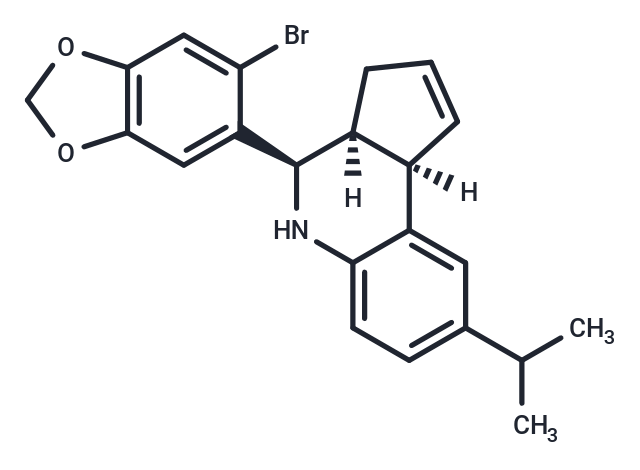Shopping Cart
- Remove All
 Your shopping cart is currently empty
Your shopping cart is currently empty

G36 is a cell-permeable non-steroidal antagonist of GPER. G36 inhibits activation by either 17β-estradiol or the GPER-selective agonist G-1 (IC50 = 112 and 165 nM, respectively). G36 has no detectable binding activity to either ERα or ERβ. G36 blocks the activation of PI3K or calcium mobilization triggered by estrogen through GPER and it suppresses ERK activation by estrogen or G-1 but not by EGF. G-36 can be used in combination with GPER-selective agonists, like G-1, to distinguish the roles of GPER from those of ERα and ERβ in complex biological systems.

| Pack Size | Price | Availability | Quantity |
|---|---|---|---|
| 1 mg | $34 | In Stock | |
| 5 mg | $80 | In Stock | |
| 10 mg | $139 | In Stock | |
| 25 mg | $253 | In Stock | |
| 50 mg | $427 | In Stock | |
| 100 mg | $632 | In Stock | |
| 500 mg | $1,350 | In Stock | |
| 1 mL x 10 mM (in DMSO) | $89 | In Stock |
| Description | G36 is a cell-permeable non-steroidal antagonist of GPER. G36 inhibits activation by either 17β-estradiol or the GPER-selective agonist G-1 (IC50 = 112 and 165 nM, respectively). G36 has no detectable binding activity to either ERα or ERβ. G36 blocks the activation of PI3K or calcium mobilization triggered by estrogen through GPER and it suppresses ERK activation by estrogen or G-1 but not by EGF. G-36 can be used in combination with GPER-selective agonists, like G-1, to distinguish the roles of GPER from those of ERα and ERβ in complex biological systems. |
| Targets&IC50 | GPER:165 nM |
| Alias | G-36 |
| Molecular Weight | 412.32 |
| Formula | C22H22BrNO2 |
| Cas No. | 1392487-51-2 |
| Smiles | [H][C@]12CC=C[C@@]1([H])c1cc(ccc1N[C@H]2c1cc2OCOc2cc1Br)C(C)C |
| Relative Density. | 1.367 g/cm3 (Predicted) |
| Storage | Powder: -20°C for 3 years | In solvent: -80°C for 1 year | Shipping with blue ice. | |||||||||||||||||||||||||||||||||||
| Solubility Information | DMSO: 55 mg/mL (133.39 mM), Sonication and heating to 80℃ are recommended. | |||||||||||||||||||||||||||||||||||
Solution Preparation Table | ||||||||||||||||||||||||||||||||||||
DMSO
| ||||||||||||||||||||||||||||||||||||

Copyright © 2015-2025 TargetMol Chemicals Inc. All Rights Reserved.